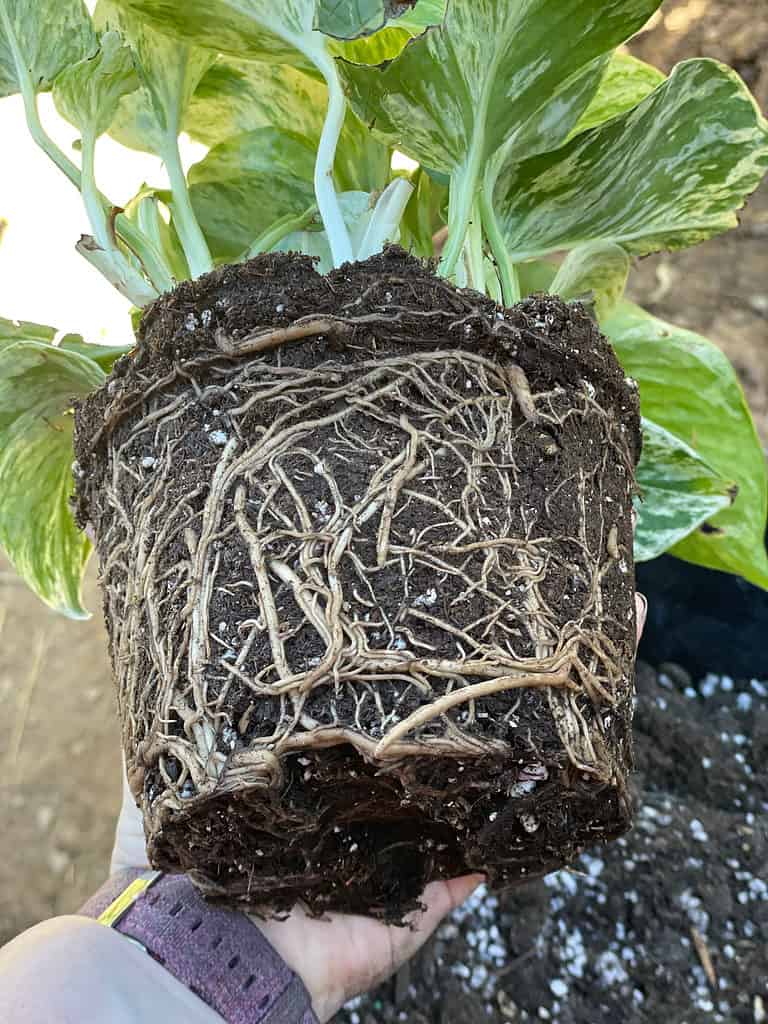If you have the popular houseplant, pothos, you may be wondering how it fares being root-bound. The short answer is that pothos does not appreciate being root-bound, and while it can tolerate roots that are lightly bound, it much prefers having space to stretch out.
In this guide, we’ll cover how pothos likes to grow, what happens to this plant when it becomes root-bound, and how to fix this issue.
So, let’s get to it!

Pothos does not appreciate being root-bound since it needs to have enough space to stretch out in the soil.
©Firn/Shutterstock.com
Pothos: Botanical Classification and Natural Growing Habit
Pothos is a tropical climbing vine that likely originated in the Solomon Islands of the South Pacific. Horticulturists have created over a dozen gorgeous cultivars of the native species, Epipremnum aureum. In the wild, once it reaches maturity, this plant can reach up to 65 feet long and has lovely variegated leaves that can grow up to 3 feet long.
As a houseplant, pothos remains in its juvenile phase and typically grows up to 10 feet long. Wild pothos climbing up trees develops aerial roots that emerge from nodes along the stem and help increase oxygen, moisture, and nutrient intake. The roots in the soil like to spread out to support the growth of this long vine.

Wild pothos climbing up trees develops aerial roots that help increase oxygen, moisture, and nutrient intake.
©iStock.com/Suprabhat Dutta
Root-Bound Pothos: How Does It Fare?
So, as we’ve touched on a bit, the roots of pothos like space to spread out, both the underground portion and the aerial roots that develop on climbing plants. In potted plants, when the roots don’t have room to spread out, they will begin circling the edges of the pot. This leads to the roots circling around the root ball, forming a tight, restrictive mass.
Now, some plants in the same botanical family (Araceae) as pothos, such as the peace lily, actually fare quite well being lightly to moderately root-bound. However, unlike the peace lily, pothos is a notably fast grower that requires a consistent supply of oxygen to grow and thrive. When root-bound, pothos does not receive enough oxygen, water, or nutrients to sustain its growing needs. As such, this plant will experience stunted growth. Eventually, when the case is severe enough, pothos will essentially strangle itself and die.
When lightly root-bound, pothos will generally survive, but it’s important to understand what exactly being “lightly” root-bound is. For pothos, this means the roots are only gently circled and can be easily separated with your fingers. The roots should in no way be tightly circled around the root ball or difficult to separate.

When root-bound, pothos does not receive enough oxygen, water, or nutrients to sustain its growing needs.
©Rebekah Zemansky/Shutterstock.com
Avoiding Root-Bound Pothos
To help pothos thrive, you’ll definitely want to avoid letting this plant get root-bound. Pothos loves growing in fertile, well-draining, and aerated soil – and when this plant is badly root-bound it no longer benefits from the nutrients, drainage, or aeration. So, there are two main ways to ensure that your lovely pothos plant won’t get root-bound:
- Make sure the plant is growing in a pot that is 2 inches bigger than the diameter of the root ball. This will provide the roots with the space they need to grow. You might be tempted to place pothos in a larger pot to prevent it from becoming root-bound, but if you place it in a pot that is too large, it is susceptible to soggy roots as the excess of soil will hold on to too much moisture.
- Repot pothos once a year into a slightly larger container to compensate for the plant’s quick growth. Under ideal growing conditions, pothos grows at a rate of about 12 inches per month during the Spring and Summer.
Root-Bound Pothos: Signs and How to Fix
If you’re concerned that your pothos is suffering from being root bound you’ll notice a few signs that the plant is struggling. These signs include:
- Stunted growth including a lack of new foliage
- Roots growing out of the drainage hole as they search for more space
- Roots emerging from the surface of the soil
- Dirt pushing through the drainage hole
- Yellow and brown leaves
- A cracked container if the pot is earthen
How to Fix
To fix root-bound pothos, you’ll need to free the constricted roots and repot the plant into a larger container with fresh, nutritive soil. So, how you free the roots depends on how badly the plant is root-bound. If your pothos roots are only mildly wrapped around the root ball, you can usually gently tease the roots apart. However, if the roots are wound around the root ball tightly, you’ll need to take a bit more of an extreme approach to allow the roots to start growing outward and downward again. For severe root-bound pothos, carefully follow the below steps:
- Remove your pothos from its current container. You may need to position the pot upside down to firmly but carefully tap the plant out of the container by tapping the bottom of the container against a hard surface while you carefully grasp the base of the plant.
- Once your plant is free, examine the roots to determine how root-bound the pothos is. If tightly constricted, you’ll need to free the roots by making some careful cuts.
- Before cutting, make sure you use sterile snips so as to not introduce infection into the freshly cut roots.
- With your sterile knife or pruners, cut about four vertical lines about 1/2 inch deep down the side of the root mass, and 1/2 inch deep X-shape across the bottom. These cuts will allow the roots to begin to grow outward and downward again, rather than continuing to spiral around the root ball.
- Replant your pothos into an appropriately sized pot with fresh soil. Take special care to not place pothos in direct sunlight after this process as the plant will be especially fragile and may experience a degree of shock from the procedure.
Up Next
- Hanging Pothos: How to Display This Unkillable Houseplant
- Do Pothos Plants Produce Flowers?
- How Big are Pothos Houseplants?
The photo featured at the top of this post is © Dragon Images/Shutterstock.com
Thank you for reading! Have some feedback for us? Contact the AZ Animals editorial team.






